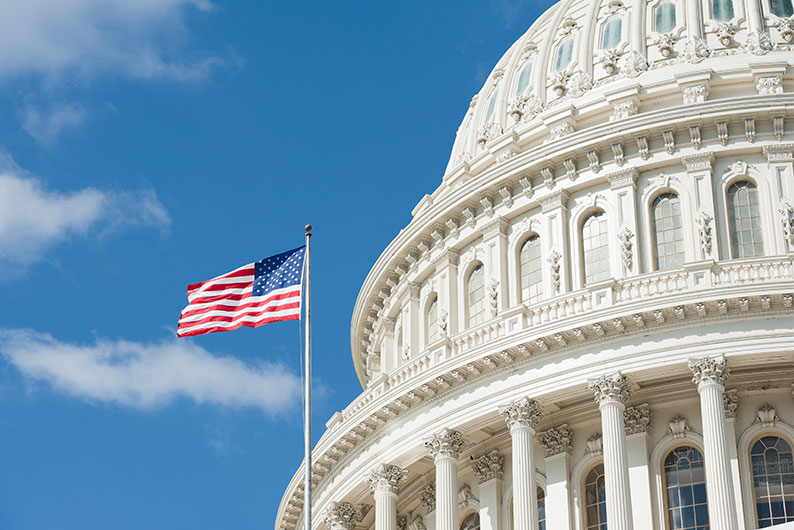Funding Intelligence
Funding intelligence, grant insights, and resources to create more equitable opportunities for school communities.
Imagine More Equitable Learning Opportunities
Education budgets are complex, and matching funding with programs to solve inequities in your community isn’t always easy. We’re here to help.

Find the help you need, including:
- Federal funding overview
- Funding STEM learning breakthroughs
- Liquidating remaining ESSER III funds
- Private sector grant opportunities
Federal Funding Overview
The federal government provides funding to schools through its primary agency, the U.S. Department of Education. Federal funding for education can be broken down into three buckets: formula, discretionary, and response formula grants. The largest amounts of money traditionally come through Title I under ESSA (Every Student Succeeds Act), and IDEA (Individuals with Disabilities Education Act).
The federal government contributes about 8–10% of U.S. public school budgets; the rest of school funding comes from state and local funds, such as tax revenues. Federal funds are given to SEAs (State Education Agencies) who sub-grant funds to LEAs (Local Education Agencies).

Main sources of federal education programs
Every Student Succeeds Act (ESSA)
Supplements state and local resources and supports students from low-income families and low-achieving schools.
Individuals with Disabilities Education Act (IDEA)
IDEA governs how states and public agencies provide early intervention, special education, and related services to more than 7.2 million eligible students and adults (ages 3–21 years old) served under IDEA, Part B.
Response Formula Grants
Funds issued through relief stimulus packages such as the CARES, CRRSA, ARP Acts (i.e., ESSER I, ESSER II, ESSER III, GEER I, GEER II, EANS I and EANS II funds) and other relief funds when critical needs arise, such as health emergencies, natural disasters, and other emergency events.
Federal PreK–12 education grants
Grant Type: Formula
Uses formulas determined by Congress to allocate funds to SEAs and LEAs.
Examples of Funds:
- Title I, Part A “Improving the Academic Achievement of the Disadvantaged”
- Title I, Part C “Migrant Education Programs”
- Title II, Part A “Supporting Effective Instruction State Grants”
- Title III, Part A “English Language Acquisition”
- Title IV, Part A “Student Support and Academic Enrichment Grants”
- Title V, Part B “Rural and Low-Income School Program”
- IDEA, Part B “Grants to States”

Grant Type: Discretionary
Awarded using a competitive grant application process.
Examples of Funds:
- Title IV, Part B “21st Century Community Learning Centers”
- CLSD “Comprehensive Literacy State Development”
- School and Community Improvement Grants
- Well-Rounded Education Grants
- Grants for Special Populations
- Charter School Programs (CSP) Funds
- Early Learning Grants
- Safe and Supportive Schools
- Teacher Preparation Grants
Competitive and Discretionary Grants
Competitive Grants
Across the country, SEAs issue varying competitive grants for eligible districts and schools to apply to a wide range of subject areas and education initiatives pertinent to the issuing state. Competitive grant funds typically derive from enacted legislation through dedicated appropriations, state funds, or even awarded federal grants.
It’s good practice for LEAs and school communities to frequently monitor SEA communications (e.g., website postings, newsletters, memos, press releases, grant system alerts, etc.) for a competitive grant opportunity for the current or subsequent school year.
Discretionary Grants
The U.S. Department of Education provides a variety of discretionary grants which are awarded using a competitive grant application process for eligible entities. These grants are traditionally issued during each federal fiscal year (October 1 through September 30) through USED’s principal offices (e.g., Office of Elementary and Secondary Education, Office of Special Education and Rehabilitative Services, Office of Career, Technical, and Adult Education, etc.) that administer the discretionary grant program. Each principal office will have different governance, funding terms and levels, program goals, objectives, and even desired results.
Let us help you with any questions or support on your grant application submission.
Federal Grant Spotlight
Comprehensive Literacy State Development (CLSD) Grants
- Purpose: Per the CLSD grant program, the discretionary grants are to “create a comprehensive literacy program to advance literacy skills, including pre-literacy skills, reading, and writing, for children from birth through grade 12, with an emphasis on disadvantaged children, including children living in poverty, English learners, and children with disabilities.”
- Recent Award: $194 million to 23 states
- Awarded States: Check out our interactive map for the awarded entity, term, grant award, and the publicly issued project goals.
Discover how our evidence-based literacy solutions and professional learning offerings can support your CLSD grant program and goals!
Funding STEM learning breakthroughs
Funding for STEM programming in the United States is extensive across federal, state, and local government entities, private individuals and institutions, and non-profit organizations. Accurate levels for every source are difficult to determine, but, broadly, the primary funding sources are:
ANNUAL FEDERAL FORMULA FUNDS
Leverage the Every Student Succeeds Act (ESSA) formula programs for supplementary STEM education.
STATE AND LOCAL FUNDS
Programs vary by state and local jurisdiction.
PRIVATE INSTITUTIONS
Corporations, foundations, individuals, and other private organizations provide grant opportunities for STEM education.
COMPETITIVE GRANTS
Government entities award STEM grants to eligible education organizations through competitive grant applications.
Learn more in our PreK–12 STEM Funding Guide.
Liquidating the Remaining ARP ESSER III Funds
Deadline Dates
- The obligation “spending” deadline was September 30, 2024.
- The statutory liquidation deadline is January 1, 2025.
- The liquidation extension deadline is March 2026.
- The U.S. Department of Education (USED) released a new FAQ (January 2024) for Liquidation Extensions.
- Insight: For all contracts that were signed by the obligation “spending” deadline may still be eligible for a liquidation extension, allowing vendors (like Imagine Learning) to continue delivering services (that are not part of multi-year agreements).
- USED example: “As an example of how liquidation extension approvals may work in practice for ARP funds, if a school district (subgrantee) contracts with a tutoring services vendor prior to September 30, 2024, and that contract meets the requirements described in this document, it is permissible for the district to both receive services and liquidate funds for up to 18 months (i.e., the initial 120-day liquidation period, plus the additional 14 months, if approved) past that date under the contract finalized on or before the obligation deadline.”
- To request a liquidation extension, SEAs must apply to the USED by December 31, 2024.
Popular ESSER Spending Strategies

High-Quality Curricula & Instruction to Accelerate Learning
Every classroom, every student is bursting with potential. That’s why Imagine Learning creates PreK–12 digital-first solutions fueled by insights from educators. We work alongside educators to support 15 million students, in over half of the districts nationwide, with school services and core, courseware, and supplemental solutions.
- Curricula: Imagine Learning’s personalized learning solutions support each student’s unique learning journey.
- Instructional Services: Certified teachers improve K–12 student performance with dynamic curriculum, proactive communication, and live instruction. Serve more students and close staffing gaps in your school with dedicated, passionate online educators and countless high-quality courses.

Specialized Services
Imagine Learning delivers equitable support and individualized learning for every student through:
- Speech Teletherapy Services: Growing staffing shortages challenge districts to give students the federally mandated speech therapy minutes they need. Imagine Learning’s nationally certified, fully licensed speech-language pathologists (SLPs) will provide services online to support students’ Individualized Education Plans (IEPs) — from home or school.
- Exceptional Education Services: Comprehensive instructional support provides districts with the resources and guidance to empower students with exceptional learning needs. SPED-certified coordinators and specialists help districts fulfill IEPs and 504 plans.

Summer & Extended Learning
Summer and extended learning programs provide opportunities for students to work on grade-level skills, receive targeted intervention, or accelerate their learning. Imagine Learning offers flexible options to customize summer or extended learning programs to move students toward their full potential.

Professional Development
Imagine Learning provides targeted training, customized sessions, and practical resources to give educators everything they need to be successful. Our flexible packages include focused professional development for each product with options for virtual or onsite delivery.

On-Demand Tutoring
Imagine Learning provides expert on-demand virtual tutors providing real-time individual student support using a secure online platform. Equitable access to one-on-one support gives students the guidance they need to move on to more complex concepts with confidence.

Small Group Targeted Instruction
Imagine Learning’s highly qualified, certified teachers provide online, data-driven Small Group Targeted Instruction (SGTI) to deliver targeted intervention in mathematics, English language arts (ELA), science, social studies, English language development (ELD), and test prep.
Quick Guide to Liquidation Strategies
|
ESSER III Liquidation Strategy |
How Imagine Learning Can Help |
Summer & Extended Learning |
Summer and extended learning programs provide opportunities for students to work on grade-level skills, receive targeted intervention, or accelerate their learning. Imagine Learning offers flexible options to customize summer or extended learning programs to move students toward their full potential. |
High-Quality Curricula & Instruction to Accelerate Learning |
Every classroom, every student is bursting with potential. That’s why Imagine Learning creates PreK–12 digital-first solutions fueled by insights from educators. We work alongside educators to support 15 million students, in over half of the districts nationwide, with school services and core, courseware, and supplemental solutions.
|
Professional Development |
Imagine Learning provides targeted training, customized sessions, and practical resources to give educators everything they need to be successful. Our flexible packages include focused professional development for each product with options for virtual or onsite delivery. |
High Intensity Tutoring |
Imagine Learning provides expert on-demand virtual tutors providing real-time individual student support using a secure online platform. Equitable access to one-on-one support gives students the guidance they need to move on to more complex concepts with confidence. |
Small Group Instruction |
Imagine Learning’s highly qualified, certified teachers provide online, data-driven Small Group Targeted Instruction (SGTI) to deliver targeted intervention in mathematics, English language arts (ELA), science, social studies, English language development (ELD), and test prep. |
Specialized Services |
Imagine Learning delivers equitable support and individualized learning for every student through:
|
What priorities does your state have for using ARP ESSER III funding?
Watch our guide to state funding guidelines with Senior Grants Director Dana Pawinski.
Imagine Learning’s Qualified Programs
Our evidence-based solutions qualify for many key PreK–12 federal funding programs:

Imagine Learning’s products, solutions, and services align to state and local funds as well as a variety of federal formula and discretionary funds and competitive grants not featured in our chart. All Imagine Learning solutions meet the ESSA evidence standards and can be used for the implementation of evidence-based interventions, programs, and activities. Learn more about Imagine Learning’s ESSA effectiveness by exploring our evidence at imaginelearning.com/essa-effectiveness. Funding alignment subject to change.
Private Sector Grant Opportunities

Education philanthropy continues to rise.
As many school community leaders remain concerned with a potential economic recession and school community leaders are concerned with budget shortfalls or a lack of funds, there are many critical decisions districts and schools are facing to ensure the most critical PreK–12 education needs are funded and can be sustained for future academic years.
Aside from the primary PreK–12 funding revenue streams deriving from state and local governments and the federal government (primarily from the U.S. Department of Education), districts and schools may also apply to competitive grant opportunities across a variety of grantmakers such as individuals, foundations, corporations, and other organizations.
Imagine Learning’s Donor Grant Toolkit
Imagine Learning is here to support the boundless potential of your students and school communities. In this toolkit, Imagine Learning’s Grants and Funding Initiatives team shares helpful resources and tips on donor relations, secrets and guides for your grant-seeking and grant-writing efforts, and resources to support your district and school communities in researching potential grants — across a variety of donors — to further support your education programs and initiatives.
This toolkit will help your school community pursue donors, reduce your preparation and grant writing time, improve the quality of your grant applications, and increase your chances of being selected for funding.
Imagine Learning’s Donor Grant Toolkit provides you with support to:
- Identify your education needs
- Find potential donors
- Engage and steward donors
- Pursue funding opportunities
- Write grant applications
Imagine More Equitable Learning
Find out more about how our evidence-based programs meet your federal, state, and emergency relief funding requirements.

